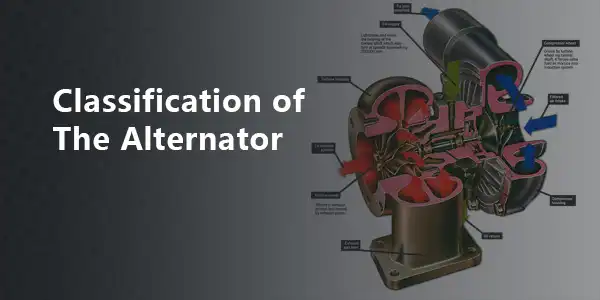Classification of The Alternator
Definition of the alternator
An alternator is a generator that converts mechanical energy into electrical energy in the form of alternating current. Most alternators use a rotating field with a fixed armature, and occasionally a linear alternator or a rotating armature with a fixed field is used. Generally, any AC electrical generator can be considered as an alternator, but usually an alternator refers to the small rotating machines that are powered by automobiles and other internal combustion engines.
Classification of the alternator
We can classify alternator types by excitation, number of phases, rotating part, and cooling method.
By excitation
1. Direct-connected DC generator
This excitation method consists of a smaller direct current (DC) generator mounted on the same crankshaft as the alternator. A DC generator produces a small amount of electricity, enough to excite the field coils of an attached AC generator to generate electricity. A variation of this system is an alternator that uses direct current from the battery for initial excitation at start-up, after which the alternator becomes self-exciting.
2. Brushless alternator
A brushless alternator consists of two alternators mounted end-to-end on a shaft. Prior to 1966, alternators used brushes with a rotating magnetic field. Advances in semiconductor technology made brushless alternators possible. Smaller brushless alternators may look like one unit, but the two parts are easily identifiable on the larger version. The larger of the two sections is the main alternator and the smaller is the exciter. An exciter has a fixed field coil and a rotating armature (power coil). The main alternator uses the opposite configuration with a rotating field and a fixed armature. A bridge rectifier, known as the rotating rectifier assembly, is mounted on the rotor. Neither brushes nor slip rings are used, which reduces the number of wearing parts. The main alternator has a rotating field and a fixed armature (generating winding).
By number of phases
Another way to classify alternators is by the number of phases of their output voltage. The output can be single-phase or multi-phase. Three-phase alternators are the most common, but polyphase alternators can be two-phase, six-phase or more.
By rotating part
The rotating part of an alternator can be either an armature or a magnetic field. A rotating armature type of armature is wound around a rotor where the windings are moved by a fixed magnetic field. The rotating armature type is not commonly used. Rotating field types have a magnetic field on the rotor, which is rotated by a stationary armature winding. The advantage of this is that the rotor circuit carries much less power than the armature circuit, making the slip ring connection smaller and less expensive.
By cooling method
Many alternators are cooled by ambient air, forced through the case by an additional fan on the same shaft that drives the alternator. In vehicles such as buses, where the demands on the electrical control system are high, large alternators may be required for oil cooling. Water cooling is also used in marine applications. Expensive vehicles may use water-cooled alternators for high electrical system demands.
 Track Your Order
Track Your Order




